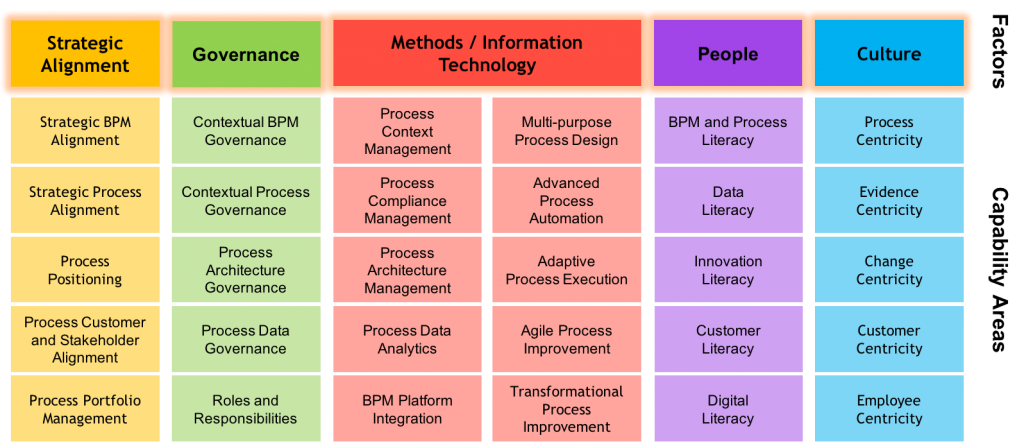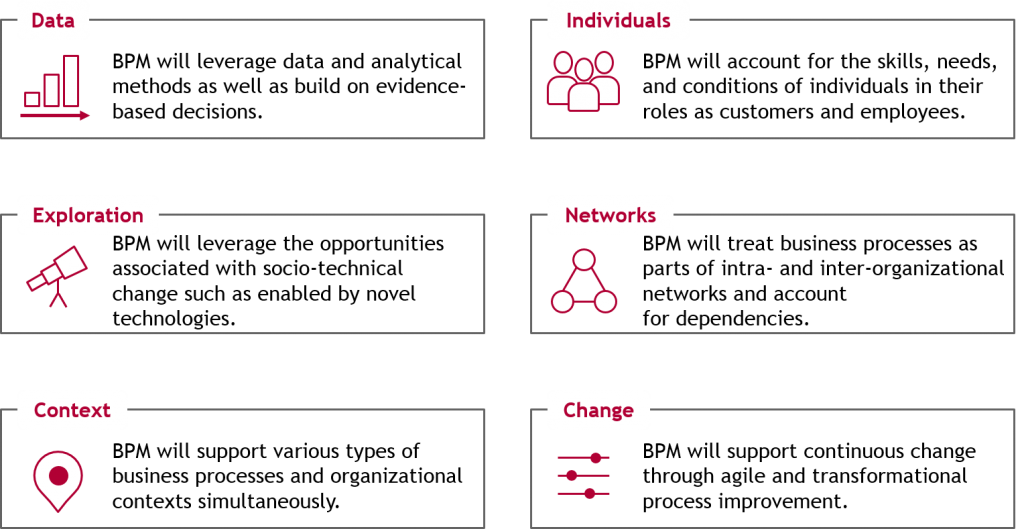BPM Capability Framework
The key outcome of our Delphi study is a framework of 30 BPM capability areas that enable effective and efficient work in the digital age. The capability areas are structured along the established core elements of BPM (i.e., strategic alignment, governance, methods, IT, people, and culture) (de Bruin & Rosemann, 2007). Based on the experts' feedback, we merged 'methods' and 'IT', as all methods can be supported by IT in the digital age.

Strategic Alignment
Strategic alignment refers to the continual alignment of organizational priorities and processes, enabling the achievement of business goals. In the digital age, strategic alignment must strongly focus on the value proposition of business processes and BPM. It must ensure that the benefits associated with business processes and BPM are realized in line with the expectations of re-conditioned, digitally savvy customers, and other stakeholders. Transparency is needed about how processes are positioned within the enterprise architecture and inter-organizational value networks. This allows for prioritizing processes in line with their need for improvement and their contribution to corporate purposes.
Governance
Governance establishes relevant and transparent accountability and decision-making processes to align rewards and guide actions. In the digital age, BPM and process governance must be highly contextual. On the one hand, this means that BPM methods and tools must be selected and customized in line with organizational contexts. On the other hand, organizations must be able to manage multiple process types and contexts simultaneously via appropriate decision-making, compliance, security, change management, and performance management concepts. Governance must define guidelines for process architecture management and process data analytics. Process data governance will be highly important for capitalizing on structured and unstructured as well as process and non-process data. In the digital age, roles and responsibilities must particularly account for new working and collaboration models as well as for new process participants (e.g., crowd workers, robots, or smart things).
Methods / Information Technology
Methods are the approaches and techniques that support and enable consistent process actions and outcomes. IT refers to the software, hardware, and information systems that enable and support business processes. Heavily IT-supported methods are needed in all BPM lifecycle phases. In the digital age, process design should fit multiple purposes (e.g., customer-centric, risk-aware, or flexibility-aware processes) and enable mass-personalized processes. In line with the importance of contextual process and BPM governance, process context management evolves into an essential capability. The same holds for process data analytics and BPM platform integration. Process execution must support the dynamic re-design of business processes as well as the handling of emerging processes and processes where no process models are available. Process improvement must support an agile and a transformational mode. The agile mode, for example, must enable the intuitive and rapid redesign of business processes as well as the fast data-driven assessment of these processes based on performance data and customer feedback. Process automation must tackle unstructured tasks and enable new forms of human-machine interaction by leveraging opportunities of digital technologies such as cognitive automation, social robotics, and smart devices.
People
People are the individuals and groups who continually enhance and apply their process-related expertise and knowledge. We identified five people-related capabilities relevant in the digital age. First, employees still require substantial knowledge about BPM methods and tools as well as about relevant process domains. To thrive in the digital age, employees must be familiar with data analytics, data privacy, and data security techniques. This also holds true for innovation techniques (e.g., design thinking), customer analysis techniques (e.g., customer journey mapping) as well as for knowledge about the mechanics of the digital economy and digital business models.
Culture
Culture comprises the collective values and beliefs that shape process-related attitudes and behaviors. In the digital age, new process values and beliefs are required. We found that it is still necessary to establish business processes as an essential topic of corporate management and to foster cross-functional thinking. In line with the access to unlimited data and the uptake of data analysis techniques, BPM requires the commitment to ground important decisions on data as opposed to managers' gut feeling. BPM in the digital age also requires the commitment to continuously scrutinize existing, even long-standing, business processes and to learn from failure in a fast and iterative manner. In the digital age, BPM must actively involve employees in process decisions, account for the effects of these decisions on employees' work lives, take customer feedback seriously, and grant employees the sovereignty to make self-dependent decisions if they encounter unprecedented challenges.
Six Overarching Themes Characterizing BPM in the Digital Age
From a bird's eye perspective, our BPM capability framework encompasses traditional and novel capabilities, meaning that current BPM capabilities do not necessarily become obsolete in the digital age. In fact, we found that many capabilities will still be relevant in the future, but need to be enhanced. For example, BPM and business processes still need to be aligned with corporate objectives and purposes. Further, method and IT support are in high need for all BPM lifecycle phases, and business processes still need to be established as central unit of analysis in corporate management.
As for novel capabilities, process governance must become contextual, meaning that organizations must support various processes types and contexts. Likewise, BPM itself needs to become contextual, meaning that BPM methods and tools must be configured in line with the process types and contexts to be supported. Consequently, it is crucial that organizational contexts are continuously monitored. Further, architectures and data will play a central role. Architectures must account for process dependencies as well as for inter-organizational processes and value networks. Data must be leveraged at design and run time for analytical and compliance checking purposes, leveraging predictive techniques wherever reasonable. As a final example, BPM must strive for the next level of process automation. Digital technologies should not only be employed for automating well-structured tasks, but also to tackle unstructured tasks together with employees and customers.
In a nutshell: In the digital age, BPM will still deal with overseeing how corporate work is performed and with the improvement of business processes (Dumas et al. 2013). Nevertheless, to serve its purpose of enabling efficient and effective work in the digital age, BPM must further exploit established capabilities and explore novel ones. To do so, BPM must embrace six overarching themes across all capabilities: data, individuals, exploration, networks, context, and change.
